If you want to buy a Cane Corso that adheres to the original breed standard as well as the AKC breed standard, you’ll need to look out for the various Cane Corso coat colors.
Beware of any backyard breeder that tries to sell you a Cane Corso with the wrong mask or colors that are not represented in the breed standard as these often carry other baggage such as developmental problems or health issues.
We’ll also dive into how breeders artificially drive the rate of the beautiful fawn, red, and formentino dogs up, not to mention the controversy around the blue Cane Corso.
But first, what colors are acceptable for the Cane Corso?
- Black
- Gray
- Brindle
- Formentino (gray mask)
- Solid Red or Fawn (black mask)
While the AKC breed standard mentions “red or fawn” as well as “solid red or fawn”, I’ve excluded the former color as that only occurs as the base color of the brindle, meaning that the color of a Cane Corso can never be red or fawn without a black or gray mask (unless he is brindled).
The mask does not go beyond the eyes. There may be a white patch on the chest, throat, chin, backs of the pasterns, and on the toes.
AKC Breed Standard
Furthermore, formentino is basically a variation of the solid red or fawn but I gave it an individual category since the formentino color is gaining in popularity and people often use these terms interchangeably, despite the genetic difference between them.
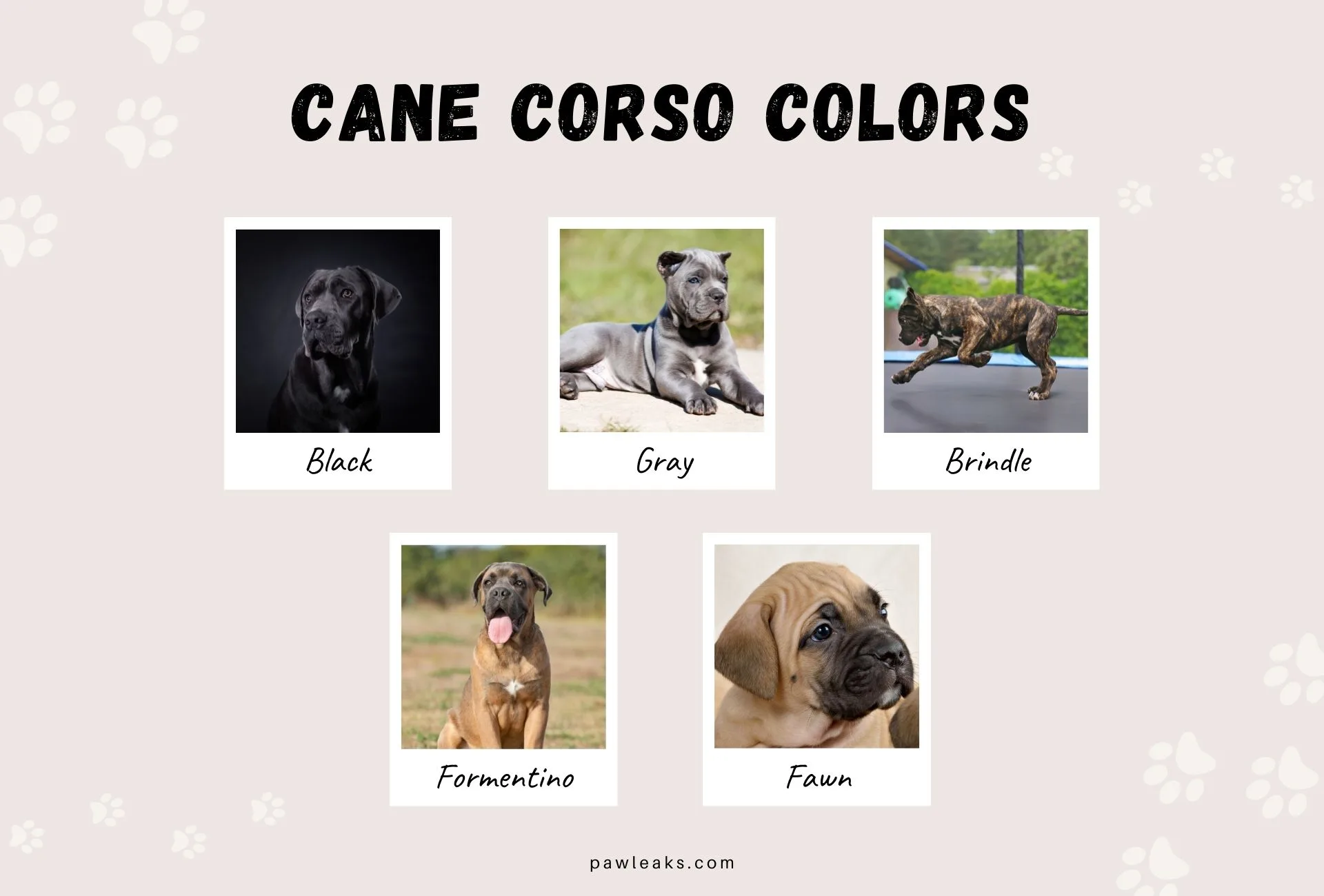
Are Blue Cane Corsos Rare?
A lot of people mention the blue Cane Corso time and time again.
There is no blue Cane Corso presented in any breed standard. What people mean when they refer to the color blue is probably the color gray.
Labeling the breed’s color wrong is not that big of a deal but a breeder that labels his Cane Corso puppies as blue-colored should signal a red flag immediately.
This means the breeder hasn’t even bothered to look up the breed standard which is the absolute minimum for responsible breeders.
Ask your breeder these questions to expose backyard breeders that are trying to scam you into buying a puppy that’s probably poorly socialized and without health certificates.
Also, stay away from anybody who calls his puppies “yellow” or “golden” when they refer to variations of red or fawn.
Black Cane Corso
Since the Cane Corso should have a smooth and shiny coat, solid black can look majestic on this breed.
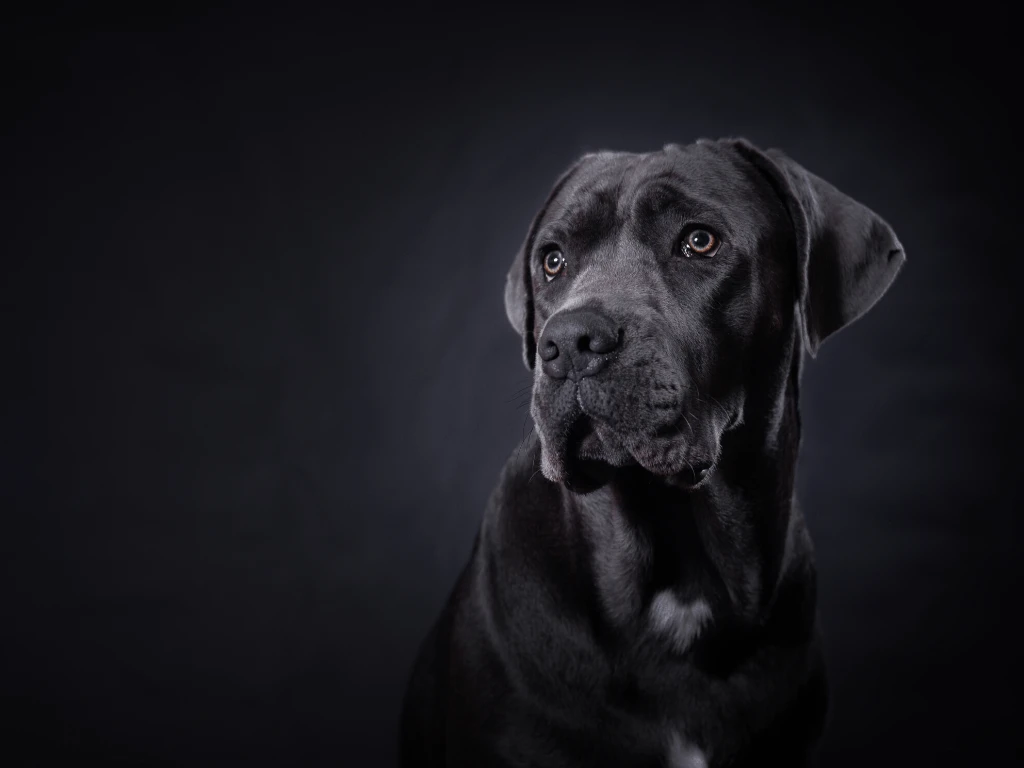
If you’re trying to predict the colors of a planned litter, this is where papers come in handy.
Black is a dominant gene, which means:
- Two black Cane Corsi will always produce black or gray puppies unless both also carry the recessive red/fawn gene (highly unlikely).
- If one of your potential puppy’s parents is solid black, chances are high that your dog will turn out to be black too.
- If one parent is black and the other is some variation of red or fawn, then the puppy could also turn out to be red or fawn or brindle, if the black parent carries the recessive gene.
- Two red or fawn Cane Corsi will always produce red or fawn puppies.
Gray Cane Corso
When an originally black puppy receives one dilute gene from each parent, he might turn out to have a gray coat color.
Gray Cane Corsos are often wrongly referred to as blue-colored.
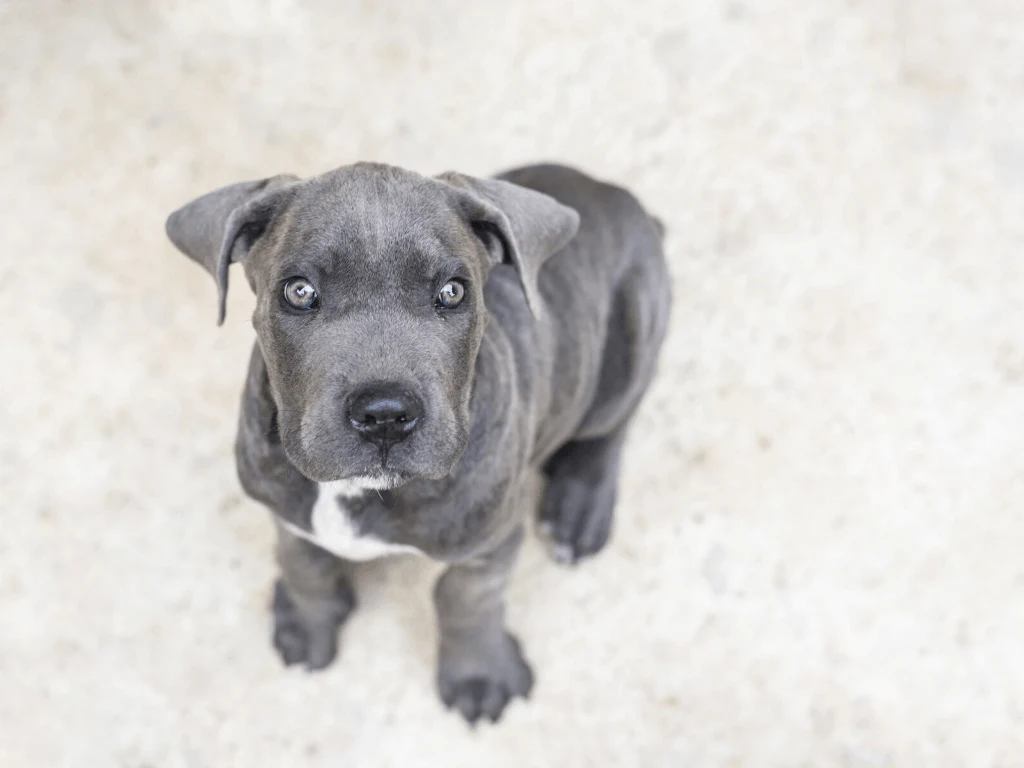
Can Cane Corso puppies change color?
Cane Corso puppies can definitely change their color to some degree.
Besides coats becoming lighter or darker, a puppy that appears to be gray at first can easily turn out to be some variation of brindle as the coat will change over time.
Brindle Cane Corso
The brindle Cane Corso color pattern sits on top of the base color red or fawn. There are several variations of brindling:
- Black brindle
- Gray brindle
- Reverse black brindle
- Reverse gray brindle
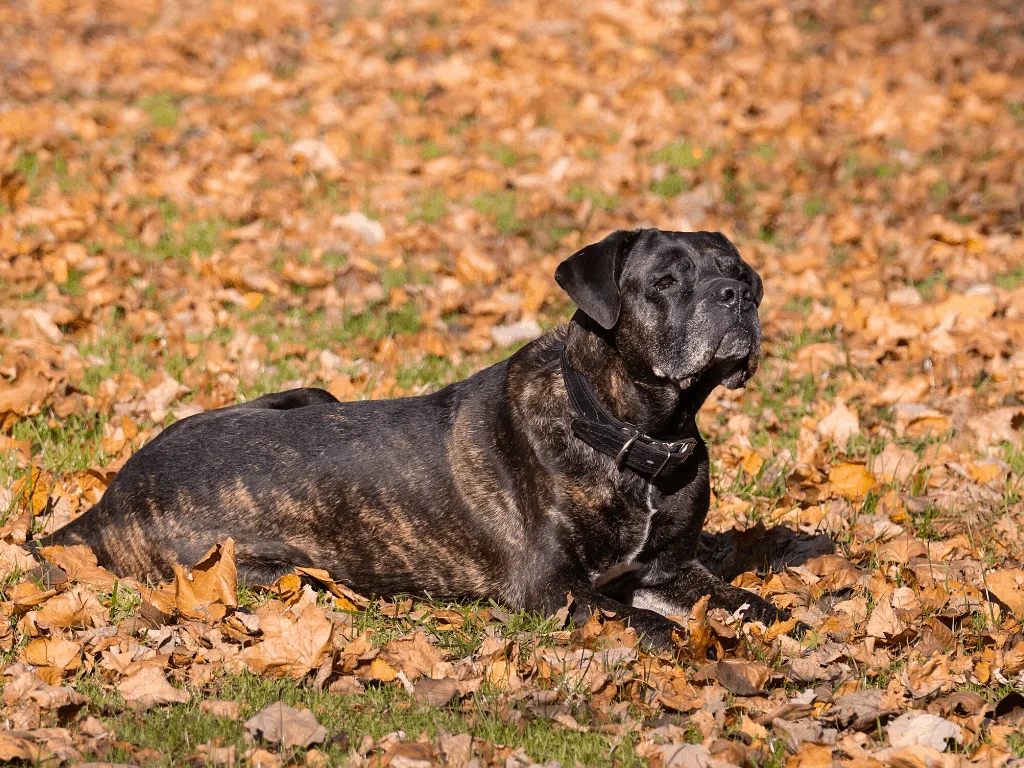
The effect of the (reverse) gray brindle is the same as with the solid gray, meaning that the puppy needs to have a diluted gene from the parents in addition to having the fawn or red genes for the base color.
Reverse colors happen due to the lighter brindling that highlights the red or fawn base color.
This means a lightly black brindled Cane Corso on a powerful red base can resemble the coat of a tiger.
It’s not known what causes the degree of brindling on a Cane Corso.
The brindle pattern can range from light to heavy.
Formentino Cane Corso
The Cane Corso’s very light fawn with a gray mask is commonly referred to as formentino, but the term you’ll find in Italian dictionaries will be “fromentino” (= “golden wheat” which describes the coat color).
Puppies have this coat color when they received a fawn/red gene from each parent, in addition to the dilute gene that makes their mask appear gray.
A solid formentino Cane Corso is probably one of the rarest coat colors of the Cane Corso.
Beware of breeders utilizing siblings for their breeding programs as the formentino coat color is highly desirable on the market and many breeders outright ignore inbreeding to make profit.
That beautiful coat may cost you big time at the vet, but more importantly, the dog will suffer from that.
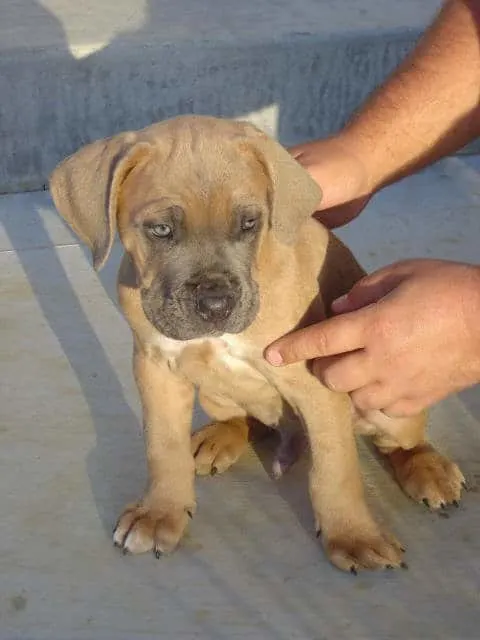
The mask should not extend beyond the eyes but the coat can vary in degrees from rich red to pale fawn.
Red or Fawn Cane Corso
As mentioned, a red or fawn Cane Corso puppy is only possible if both parents were carriers of the genes (they can be either black or red/fawn themselves).
This coat color is always accompanied by a black mask and the colors range from bronze and very rich red, all the way to light creamy fawn coats.
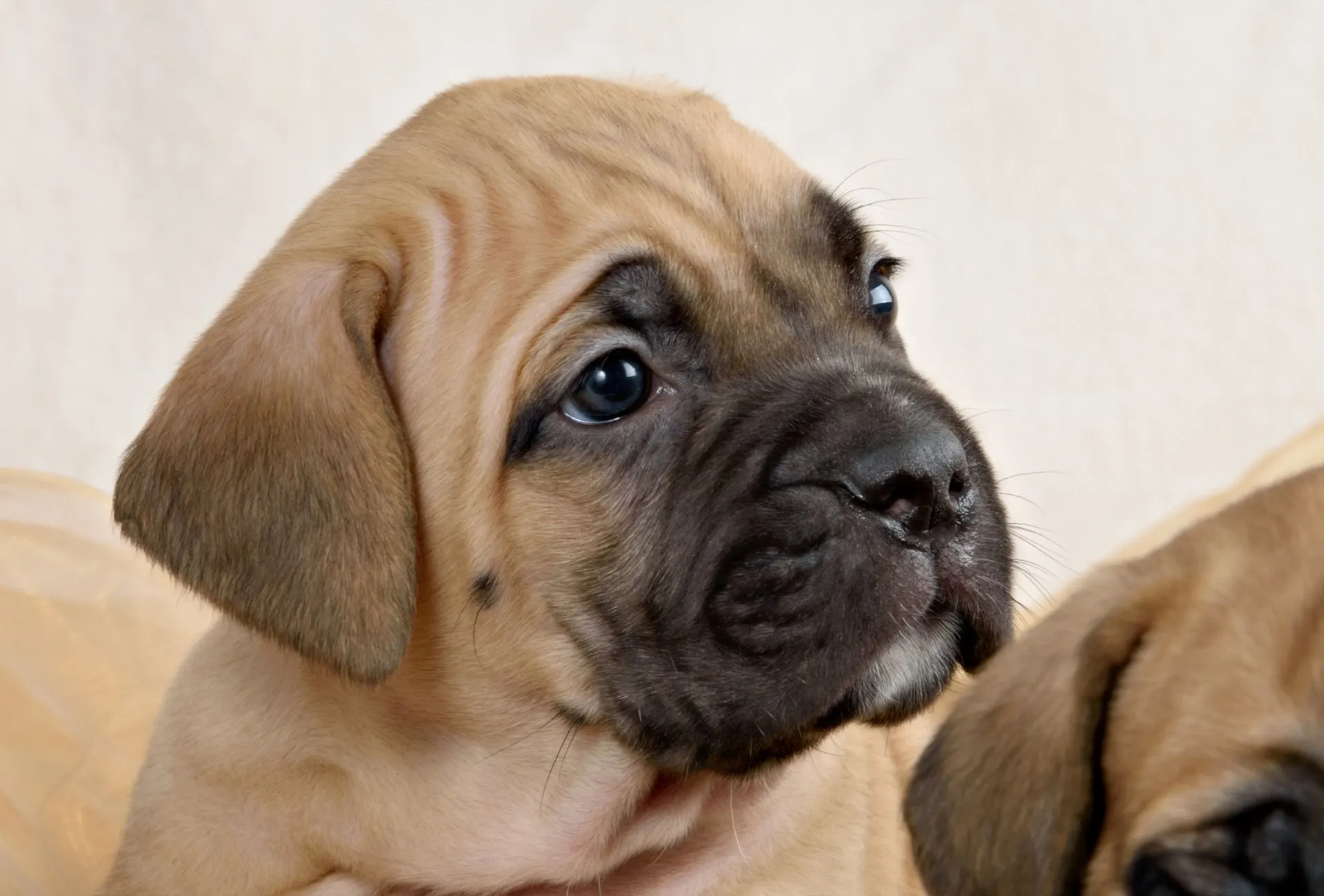
Cane Corso Lifespan Related to Coat Color?
It might surprise you, but according to a couple of studies, there seems to be a correlation between coat color and lifespan.
This study obtained data from over 232 naturally deceased dogs (no accidents or poisonings), owned by 73 individuals/kennels, living in 25 countries.
While this seems one of the biggest studies of this very specific kind, it’s not exactly a huge sampling number and the fact that there are on average over 3.17 dogs/individual might make for even less reliable data.
Also, there are various different countries but the main focus is on (Eastern) Europe.
So take the results with a grain of salt but here they are:
- Black Brindle: 10.30 years
- Brindle: 10.13 years
- Grey Brindle: 9.84 years
- Fawn: 9.01 years
- Black: 9.00 years
- Grey: 9.00 years
- Other: 8.09 years
On a more uplifting note: There are Cane Corsi reported to be pretty healthy for up to 18 years.
How to Improve Your Cane Corso’s Lifespan
There are several ways to make sure your Cane Corso lives healthy until old age.
- Love and great care
- Low-stress environment (here are a couple of indestructible & orthopedic dog beds that will lower the risk of arthritis)
- Plenty of exercise
- Healthy raw diet
Other Cane Corso Colors
Besides the colors mentioned above and their variations, no other colors are permitted according to the breed standards.
I’ve seen dogs offered in the merle pattern which definitely does not occur in the Cane Corso.
Besides being undesirable, the merle coat color means that your dog is not a purebred but a crossbreed.
Always ask for papers and don’t let them tell you that various other lines were used several generations ago, it’s still a crossbreed with all the possible health/behavior issues.
If you come across a breeder offering these kinds of puppies, following my breeder questions article above will ensure you’re not buying into any breeder’s scam.
White Cane Corsi don’t naturally occur either unless the dog has albinism.
If you want to know more about that condition, feel free to read my article on pink dog noses related to albinism.
Do Cane Corso Eyes Change Color?
If you want to know if Cane Corso eyes stay blue, the answer is definitely no as a puppy’s blue eyes will dilute and change eye color within a couple of weeks or months.
Their blue eyes can definitely turn brown once they’re adults.
Fawn or formentino Cane Corsi will look stunning with the cute blue eyes but don’t be fooled by a breeder charging you extra for these puppies.
If that is the case, you shouldn’t buy from them at all either.
Read my article on the controversy around the blue-eyed Pitbull for more information.
Let me know what’s your favorite Cane Corso coat color and feel free to ask any questions about your potential puppy’s colors in the comments.

Sandra Lunn
Friday 24th of May 2024
I have a Cane Corso/Boxer mix but I question the Boxer part. He shows no characteristics of the Boxer, and looks a whole lot like the Cane Corso. He is solid black with white on his chest and is a BIG lover!! He weighs 130 lbs. He is a rescue and his name is Gabriel. Gabe is two years old. Gabe has two Boxer brothers and a Boxer sister. We have a very happy pack!!!! Lol
Shalee
Tuesday 23rd of March 2021
I have a female Formentino that has no white on her. Does that mean she is a solid formentino?
Danielle
Tuesday 23rd of March 2021
Hi Shalee, if your dog does not have a black mask but instead a gray mask and it's the creamy coat color without white, then yes, that's most probably a solid formentino. Beautiful coat color for sure. If your dog has a pedigree, you can check ancestors and see what colors they all had :).
Cheers, Danielle
Shalee
Tuesday 23rd of March 2021
No white on her not one her!
Maryjane Krueger
Friday 13th of November 2020
Danielle, I rescued a gray brindle named Lola. She became my mobility service dog but unfortunately the abuse she suffered before we got to her was so grave it was impossible to save her even tho she survived a splenectomy she couldn't overcome giganticism and we lost her. Soon (three years) we rescued a Old English Mastiff Male again abused, but unfortunately not social enough to train as a service dog. Please be is a great dog but only to family and close friends. I am longing for my Cane Corso, but we can not find a breeder near me could you help with a breeder or rescue group to find a girl?
Danielle
Saturday 14th of November 2020
Hey Maryjane,
I'm sorry for your loss and totally understand your wish for a compatible companion besides your Old English Mastiff. Awesome that you're rescuing these poor souls but please be aware that getting a puppy can quite the challenge in and of itself but especially if your Mastiff also lives in the same house and might not be the most social dog. Even if he is very social with puppies, two giant breeds like this will be really challenging, make sure you have the space, time, and money to raise a pup.
That being said, I live in Germany and have breeder contacts here but I don't know US breeders well enough to really recommend one. I love Cane Corsi and would absolutely recommend going the distance for a healthy. well-tempered puppy, even if it means that you'll have to drive pretty far for your next pup. Too many scammers selling poorly bred dogs like here and here (both interesting Yt channels by the way).
It's great that your last Cane Corso was suitable as a service pet but (depending on your requirements), most rescued dogs probably won't fulfill these requirements and need even more training instead.
Whatever you decide, make sure to read my article on questions you should ask your breeder or the one for dog adopters. Asking yourself and your breeder/rescue these questions will help you a great deal with identifying the good ones and staying away from the bad ones :).
Cheers, Danielle
Aaron Wilson
Saturday 7th of November 2020
I have a gray puppy I would like a response back so I could talk to you about raising my puppy right also would like more information on training classes as well as in the address what part of Philadelphia are you located in.
Danielle
Saturday 7th of November 2020
Hey Aaron,
thanks for writing. I'm sorry but I'm not located in Philly, I'm currently living in Germany :).
I've got quite a few articles on puppy training though. You may want to check these out: - Cane Corso developmental stages - Puppy biting - Potty training - Socialization - Separation anxiety
Cheers, Danielle
Colin Bruce
Wednesday 16th of September 2020
Hi, my name is Colin and I have two corso currently. A red fawn male who is 12 years old, and a solid lead gray female who is 5 years old. I love them both, and desire to have an offspring from my male who is absolutely magnificent. What is your opinion on breeding my corso? I’m apprehensive due to so many animals ending up in shelters, and wouldn’t want any pups from my litter going to irresponsible owners. Should I breed,purchase, or adopt a new corso when my beautiful male is no longer with our family?
Danielle
Wednesday 16th of September 2020
Hey Colin,
great that you're thinking it through before breeding! The desire to have offspring from your own dog is understandable and even though it would solve your question of which dog to get after your current male isn't with you anymore, many things need to be considered.
- Do you have the time/money/knowledge/space to raise around 4-8 healthy and well-socialized puppies? - Which dog would you want to pair your male with (keep in mind that pairing one dog with the other dog in the household is not the best choice in most cases in terms of temperament) - Is your male Corso healthy (x-rays to rule out hip dysplasia, heart issues, etc. etc.)? Since your dog is 12y already, the sperm quality may suffer extremely, whereas females shouldn't be bred after 4-5 years, and definitely not with 4y if it's her first time. You can read more about how old is too old for a dog to have puppies.
If you can positively answer all the questions every breeder should be able to answer, then I'm not against breeding proper canine citizens.
However, if you really just want to breed to have offspring from your own male, it might be better to adopt instead of shop (or breed). Check these adoption questions to find the right Corso for you. They often come with baggage and require lots of training, socialization, etc. but I'm sure you're familiar with that after owning two dogs of this magnificent breed. This is a great way to provide second chances for these big boys that are often unwanted once they grow up and are adults.
Of course, getting a new puppy from another breeder is another option. I personally wouldn't worry about this right now if your Corso is healthy but it's good to keep an eye out for great breeders if that's what you're looking for. However, if you've gotten your two dogs from a breeder already, adopting could be a great switch and provide you with new experiences/challenges :).
Hope this and the linked articles help with your decision, Danielle